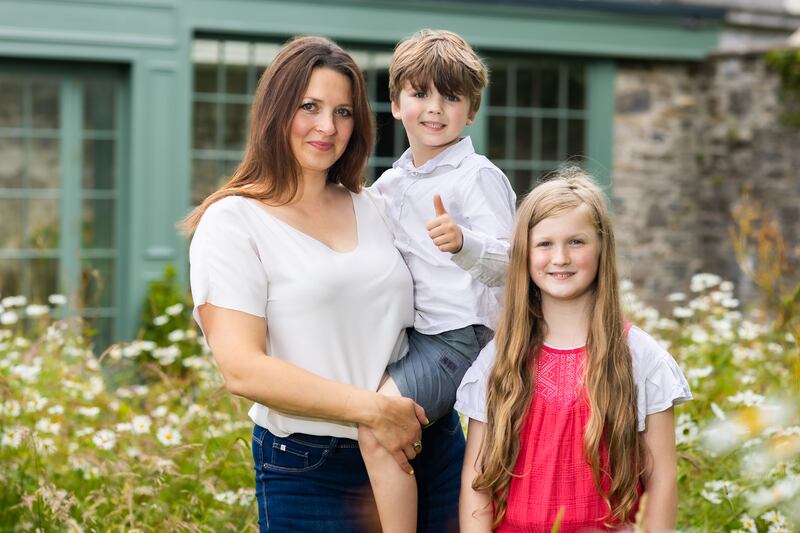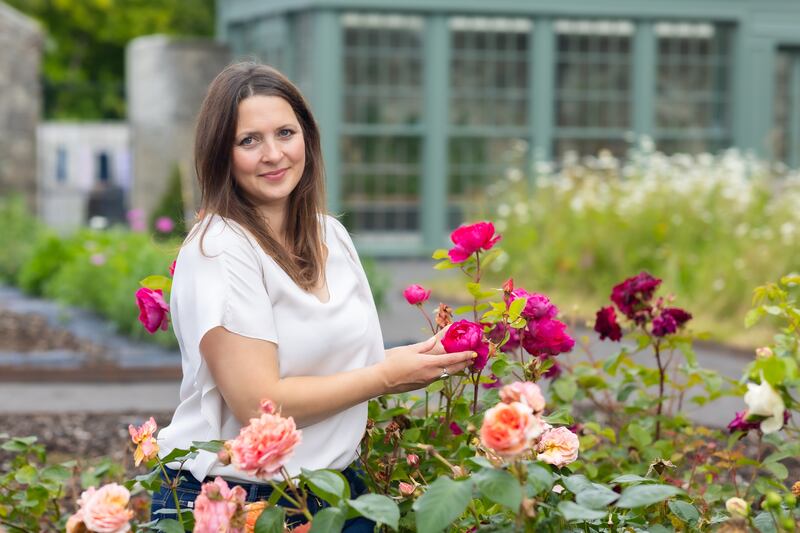It is literally a walk in the park or a sneak pad across a quiet landing, if feline family member, Pause, finds the schedule of workshops at Coolamber House too noisy when he needs a catnap.
From examining busy beehives to fluttering flotillas of wildflowers, there are classes in table-scaping and cocktail making, vegetable growing and wreath making. Add in the wine-tasting evenings and it is not only the fragrance of vases of cut flowers from the gardens that are wafting through the air of this Co Westmeath house, once owned by a princess.
Just two weeks before giving birth to their youngest son, Paddy, in 2016, Ann Marie Durkin and her husband, Patrick, moved into their period house in the townland of Lismacaffrey. Since the couple already lived locally, they were fascinated by Coolamber, and, when it came up for sale in 2014, buying it was a dream come true.
“Like many period houses in a small rural area, it is very much part of the locality. When it came on the market we were lucky to be in a position to purchase it,” explains Ann Marie.
READ MORE

So lock-stock-and barrel, Ann Marie and Patrick moved with their five children: Sam, who is now 16-years-old, Ben (15), Jake (13), Anabelle (10) and Paddy (5), as well as afore-mentioned Pause, and Honey and Sunny, the family’s two labradors.
Built circa 1850, the present Coolamber House is an important part of Co Westmeath’s architectural heritage. It may incorporate part of an earlier house and was also originally the site of a castle. Once the home of Percy Philip O’Reilly, an Olympics polo player who was part of the team which won silver at the 1908 Olympics, these days it is a buzzing and bustling family home.
This 19th century house had been the home of Prince Ernest and Princess Virginia of Saxony who arrived in Ireland in 1946, having fled the Russian and ally bombings in their hometown of Dresden. Poignantly, the princess continued to live in Coolamber as a widow for more than 50 years, and died in 2002.
Inspired by the heritage of the home, the Durkins are busy translating a book written by the prince, From the Palace to the Farm.

The renovation of the property has been gradual.
“We had worked on some of the major jobs like rewiring and re-plumbing the house for two years before we moved in 2016. We were very excited about the potential of Coolamber, but were not too surprised when we encountered all the usual issues you hear about when undertaking a major restoration project,” Ann Marie says.
They grappled with subsidence, a leaking roof, missing slates, wet rot, dry rot and drainage issues. After that, it was time to start work on the garden, the stables block, tack rooms, glasshouse, gardener’s cottage and potting shed.
“Our one-acre walled garden was an overgrown jungle and all that remained was two fallen apple trees. The walls, although mostly intact, were completely covered in ivy,” she says.
“Our overall design for the main gardens was a mix of formal and less structured areas including an orchard, kitchen garden, wildflowers area, nuttery, currant garden, rose and cutting flower garden.”
Indeed, the restoration project is not finished yet with the old dairy courtyard and its shed to be tackled next.

At the outset, the Durkins felt there was a niche for gardening workshops for the home gardener and, ironically, the pandemic focused locked-down people’s minds on the huge potential of their outdoor spaces.
“Many gardening or horticulture courses are academic and accredited, while most people just want to know how to manage and maintain their own gardens,” Ann Marie says.
“The pandemic really opened people’s eyes to how dependent we are on everyone else for our food supply. It gave them time to make herb gardens or simply enjoy a seed-sowing activity with their children.”
Since gardening and interiors have always been her passion, Ann Marie started her innovative business, which she stresses “does not feel too much like work”. Well, there is lots of on-hand family help too as she prepares for her variety of workshops, held in the renovated outbuildings.
“Running the workshops also helps to keep the focus on continually improving the house and garden. It brings us great satisfaction to see the house fully lived in and the outbuildings utilised,” she says.
Mill tours
Another major conservation project was embraced after Irene and Marcus Sweeney purchased Fancroft House and Mill back in 2006.
Situated north of Roscrea, Co Tipperary, the site actually straddles the border with Co Offaly. A tributary of the Little Brosna river, which is part of the Shannon system, runs right through the mill.
Fancroft — which translates as Fionn Choradh, or the white weir — was one of five mills once situated on this tributary. The oldest section of the mill dates from circa 1780, and is associated with the Pim family, who were Quaker millers.
As Marcus explains: “In the early to mid-1800s, there were circa 5,000 mills in Ireland and consequently each catchment area for the supply of grain tended to be very local.”
There is a certain serendipity to their purchase of the property, as the couple began considering moving back west nearer their Co Galway roots for their retirement.
“A property feature in The Irish Times sparked our interest in a lovely three-bedroom Quaker house, despite its location in ‘middle Ireland’. Neither a derelict mill nor a very large garden was on our wish list,” says Irene.
She says that the house was largely in good condition, having been sensitively conserved by its previous owner, garden architect, Angela Jupe.
However, the mammoth conservation project of the mill initially involved major structural intervention works on the roofs, 90 new sash windows, the maze of floors and three and four-storey stone walls.
Ongoing expert advice from Offaly County Council’s heritage officer, Amanda Pedlow, and heritage architect, Rachel McKenna has been invaluable.
In so far as possible, much of the work was completed by skilled craftsmen, both local and from Clare Island, Co Mayo, where the Sweeneys have holidayed for more than 30 years.
By 2010, a new set of mill stones had been installed, thus restoring the milling capability for domestic purposes.
“Crucial to the micro-hydro installation and the restoration of the milling capacity was the involvement of Jochen Koehler and his team from Weimar in the German region of Thuringia. We are delighted that work on two further Irish mills followed from the profile gained as result of the excellence of their input at Fancroft,” says Marcus.

In 2017, the Sweeneys were honoured with a Conservation Award by the Irish Georgian Society for their rescue of the mill complex from dereliction. Two years later the project received the inaugural Norman Campion award for Best Restored Industrial Site or Museum.
The gardens at Fancroft Mill are now private but there are continued tours of the mill, with refreshments served in the tearoom when booked in advance. The story of the history of the mill and the conservation project is presented in the lecture room upstairs, which is also used for various heritage events.
A section of this upper floor has been dedicated to the archive of the Mills and Millers of Ireland (MMOI).
The Sweeneys also host charity events — classical and traditional music concerts and recitals — in the performance area. Their most recent event was hosted in collaboration with Music for Galway, and featured talented young Galway cello ambassador, Catherine Cotter, who gave a recital for a small audience of invited guests.
‘Home from home’
While some of the big old properties in rural Ireland have been lucky to be saved by passionate new owners, Enniscoe House has been owned by the same family for 13 generations.
Secreted down a winding avenue of beech and oak, and overlooking Lough Conn, it is near the little town of Crossmolina in north Co Mayo. It is a classic Georgian house which, interestingly, has been incorporated into an older house built in the 1740s. The joining to the original house is clearly visible behind the Georgian reception rooms and staircase.
Enniscoe has been operated as a Blue Book guesthouse for many years by Susan Kellett and more recently, with the help of her son DJ, who lives in one of the courtyard buildings with his wife, Collette and two daughters, Fearne (4) and baby Hilary, born this June. Other sections of this complex have been converted into self-catering apartments.
Situated in the courtyard also are the offices of the North Mayo Heritage Centre, whose genealogists traced the details of president Joe Biden’s roots in Ballina.
“These types of houses are not museums and their story has not yet finished, because of their nature a lot of history has happened around them and it is vital that is not lost,” DJ explains.
“General Humbert’s French army stopped at Enniscoe on the way to the battle of Castlebar in 1798, for example.”
Welcoming guests — offering a “home-away-from-home” — from April to October is an important aspect of Enniscoe. It espouses a very homely ambience with crackling wood fires, old family portraits, more recent sketches, exotic bric-a-brac and well-thumbed books.
However, the real economics of ensuring the continued viability of the house and estate means the Kelletts have to constantly innovate.
“We have recently gone into a partnership with the NPWS (National Parks and Wildlife Service) and their rare breed programme. So there are now Moiled cows, Cladagh sheep and Connemara ponies on the grasslands of Enniscoe. This partnership is the first of its kind in Ireland,” DJ says.
Enniscoe, like so many businesses, is still recovering from the challenges of the pandemic lockdowns and restrictions.
“Everything is back open in the house, but the cafe in the heritage centre did not survive Covid. We have been unable to find anyone to open it again,” says DJ.
“[In the] meantime, the organic garden is doing very well because the work could continue, as it was classed as a food production garden. The ornamental garden is back open to the public again, but as there hasn’t been a gardener working there for two years, it has been a tough job to ensure it looks its best again.”



















